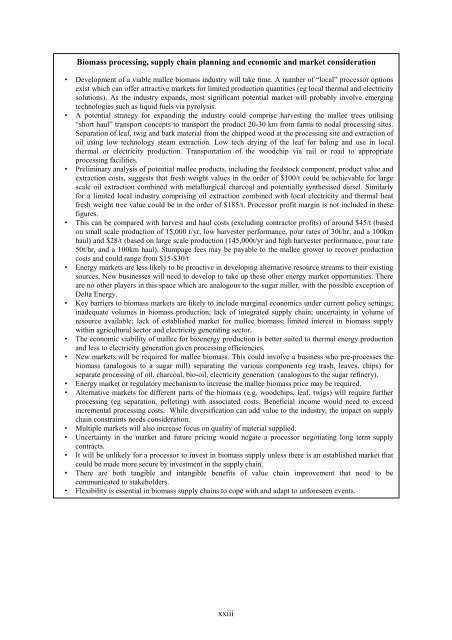Download (4Mb) - USQ ePrints - University of Southern Queensland
Download (4Mb) - USQ ePrints - University of Southern Queensland
Download (4Mb) - USQ ePrints - University of Southern Queensland
Create successful ePaper yourself
Turn your PDF publications into a flip-book with our unique Google optimized e-Paper software.
Biomass processing, supply chain planning and economic and market consideration<br />
• Development <strong>of</strong> a viable mallee biomass industry will take time. A number <strong>of</strong> “local” processor options<br />
exist which can <strong>of</strong>fer attractive markets for limited production quantities (eg local thermal and electricity<br />
solutions). As the industry expands, most significant potential market will probably involve emerging<br />
technologies such as liquid fuels via pyrolysis.<br />
• A potential strategy for expanding the industry could comprise harvesting the mallee trees utilising<br />
“short haul” transport concepts to transport the product 20-30 km from farms to nodal processing sites.<br />
Separation <strong>of</strong> leaf, twig and bark material from the chipped wood at the processing site and extraction <strong>of</strong><br />
oil using low technology steam extraction. Low tech drying <strong>of</strong> the leaf for baling and use in local<br />
thermal or electricity production. Transportation <strong>of</strong> the woodchip via rail or road to appropriate<br />
processing facilities.<br />
• Preliminary analysis <strong>of</strong> potential mallee products, including the feedstock component, product value and<br />
extraction costs, suggests that fresh weight values in the order <strong>of</strong> $100/t could be achievable for large<br />
scale oil extraction combined with metallurgical charcoal and potentially synthesised diesel. Similarly<br />
for a limited local industry comprising oil extraction combined with local electricity and thermal heat<br />
fresh weight tree value could be in the order <strong>of</strong> $185/t. Processor pr<strong>of</strong>it margin is not included in these<br />
figures.<br />
• This can be compared with harvest and haul costs (excluding contractor pr<strong>of</strong>its) <strong>of</strong> around $45/t (based<br />
on small scale production <strong>of</strong> 15,000 t/yr, low harvester performance, pour rates <strong>of</strong> 30t/hr, and a 100km<br />
haul) and $28/t (based on large scale production (145,000t/yr and high harvester performance, pour rate<br />
50t/hr, and a 100km haul). Stumpage fees may be payable to the mallee grower to recover production<br />
costs and could range from $15-$30/t<br />
• Energy markets are less likely to be proactive in developing alternative resource streams to their existing<br />
sources. New businesses will need to develop to take up these other energy market opportunities. There<br />
are no other players in this space which are analogous to the sugar miller, with the possible exception <strong>of</strong><br />
Delta Energy.<br />
• Key barriers to biomass markets are likely to include marginal economics under current policy settings;<br />
inadequate volumes in biomass production; lack <strong>of</strong> integrated supply chain; uncertainty in volume <strong>of</strong><br />
resource available; lack <strong>of</strong> established market for mallee biomass; limited interest in biomass supply<br />
within agricultural sector and electricity generating sector.<br />
• The economic viability <strong>of</strong> mallee for bioenergy production is better suited to thermal energy production<br />
and less to electricity generation given processing efficiencies.<br />
• New markets will be required for mallee biomass. This could involve a business who pre-processes the<br />
biomass (analogous to a sugar mill) separating the various components (eg trash, leaves, chips) for<br />
separate processing <strong>of</strong> oil, charcoal, bio-oil, electricity generation (analogous to the sugar refinery).<br />
• Energy market or regulatory mechanism to increase the mallee biomass price may be required.<br />
• Alternative markets for different parts <strong>of</strong> the biomass (e.g. woodchips, leaf, twigs) will require further<br />
processing (eg separation, pelleting) with associated costs. Beneficial income would need to exceed<br />
incremental processing costs. While diversification can add value to the industry, the impact on supply<br />
chain constraints needs consideration.<br />
• Multiple markets will also increase focus on quality <strong>of</strong> material supplied.<br />
• Uncertainty in the market and future pricing would negate a processor negotiating long term supply<br />
contracts.<br />
• It will be unlikely for a processor to invest in biomass supply unless there is an established market that<br />
could be made more secure by investment in the supply chain.<br />
• There are both tangible and intangible benefits <strong>of</strong> value chain improvement that need to be<br />
communicated to stakeholders.<br />
• Flexibility is essential in biomass supply chains to cope with and adapt to unforeseen events.<br />
xxiii
















